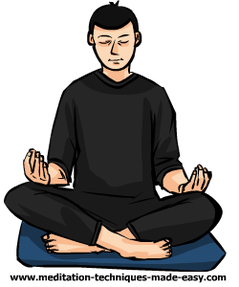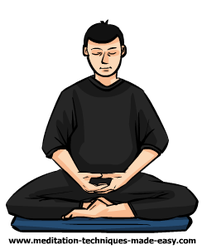
How To Do Meditation At Home
by marciag
If you want to learn how to do meditation at home, there are some very easy steps you can follow for best results.Meditation is healthy, is fun and is a welcome change from stress.
What Is Meditation?
And why would you want to meditate?
 Meditation is the ancient art of sitting in quiet contemplation. In history meditation was considered a way of life by Buddhists and other spiritual leaders of the East.
Meditation is the ancient art of sitting in quiet contemplation. In history meditation was considered a way of life by Buddhists and other spiritual leaders of the East.
Due to the many benefits (health and otherwise) that practicing meditation offers, it has been eventually picked up by the Western society as well. No wonder since meditation is one of the best remedies for stress relief.
And let's face it, we all deal with stress every day in our lives.
One of the issues that people had to overcome in our society is how to get those benefits as fast as possible without spending years alone in isolation like the monks in Tibet.
Since people have been always very creative in getting what they want, there have been many ways adapted for meditation in an easy and fast way, so that we can meditate each day for just a bit (let's say 20 minutes at a time) and soon enjoy all the advantages that such a practice can offer us.
To do meditation at home is very easy, and this article will show you ways to do it from the comfort of your own home.
(Image copyright: marciag)
Eckhart Tolle On Meditation
Are You Meditating Regularly?
Easy Techniques Of Meditation
If you want to learn to meditate at home, there are countless meditation techniques that you can start with. And the good thing about these techniques is that you will see the health and stress reduction benefits quite soon - sometimes as fast as in a couple of days.
The only thing requited is to practice every day. And let's face it, even with our overly full days, we can get 10 or 20 minutes away from our busy schedule to have a bit of time for ourselves.
Just think of meditation as your personal time, away from the stress, worries and problems that your daily routines at home and at work give you.
Some of the easy techniques of meditation are:
- Binaural Beats - Sounds that affect our brainwaves to alter our state of mind, our mood and help us get into the alpha state of mind, which is needed to enter a meditation state.
- Accelerated Meditation Techniques - While binaural beats are also considered techniques that accelerate meditation, there are several others as well, including the well known Mudrashram® Accelerated Meditation Program and TM Meditation.
- Meditation CDs that have either sounds of nature or relaxation music (sometimes Reiki music is used for meditation as well)
- Guided Meditation- You simply listen to a voice guiding you to relax your body and min and enter a meditative state quite fast
Below I will discuss some of these techniques more in detail.
General Tips For Meditating At Home
No matter which meditation type or technique you are using for your daily meditations, there are a few things you need to do whch are mostly the same every tiime.
- Find some quiet time when you know you will not be disturbed for the duration of your meditation. While initially you might start with 5-10 minutes, if you meditate regularly, be prepared to increase your time to at least half an hour every day.
- Also make sure that this time is approximately the same. Thus if you like to meditate late in the evening when the family has already gone to bed, then do it on a consistent basis using the same time every day.
- You need to find the right meditation posture. This article gives you some of the most popular meditation postures for your practice. I personally use the Sitting in a chair posture as I find it to be the most comfortable for me. You can experiment until you find your best way to sit while meditating.
- Take a few deep and slow breaths to remove the stressy thoughts of the day from your mind. No matter which technique you use, when meditating you will learn to let go of short and shallow breathing as this doesn't serve you well. When you use guided meditations, the voice of the guide will walk you through the proper breathing technique.
- If you find that you tend to lose track of time, have an alarm nearby that you set to go off at the end of your practice. After a while you will find that you no longer need the alarm, but for beginning meditation, it is a welcome meditation accessory.
- When you finished your meditation, sit for a minute longer in that comfy position with your eyes closed. Be relaxed and come out of your altered state of consciousness easily, without haste. First remember where you are, remember what you did just before starting your meditation session, then slowly open your eyes, and then start moving and stretching your body.
- Always ground before and after meditation (especially after). This means drinking a glass of water, washing your hands, touching a plant, something that will ground you back to your normal reality.
Meditation Accessories That Will Make It Easy To Relax Faster
 |  |  |
| YogaAccessories (TM) Round Cotton Zaf... | Meditation Timer - Sycamore | 4 in 1, Yoga Meditation Kit: Yoga Mat... |
Listening To Binaural Beats
I personally find listening to binaural beats one of the easiest ways to meditate at home. If you think, however, that this is like listening to any music while doing your regular chores, this is nothing like this. So here is the way I do my daily meditation at home using binaural beats.
- Follow the tips I mentioned above for starting your meditation at home. Find a comfy position, make sure you are not disturbed, clear your mind and regulate (slow down) your breathing.
- For binaural beats I use headphones that cancel out the external noise for no interruptions (dogs barking, cars passing, people talking outdoors, etc). Another reason for using headphones is because binaural beats are two separate tones that need to be heard each in one ear. The difference between the tones (in hertz) will give you that brainwave entrainment that you are after - to put you in a state of deep relaxation.
- Depending on the CD you are listening to, some might have white noise (like the noise of your fan), while others will have vibrating tones, and others (my favorites) will have various nature sounds, such as the rain falling, ocean waves, birds chirping, as background.
- Make sure that you never listen to binaural beats while you're driving or you're otherwise engaged. Not only that it will not have the desired effect, but you might get in a dreamy state whereby you won't be able to focus on what you're doing. Completely zoning out is NOT what you should be doing when driving to or from work!
- Simply clear your mind and listen to the CD. Some people have a 'story' that they run each time they listen to the binaural beats. For example they imagine walking in a garden, seeing the birds chirping, or being at the seaside watching and listening to the ocea waves...Other people simply enjoy the sounds without any specific visualization. It's up to you which way you do it - they are all perfect ways to meditate.
Binaural Beats CD I Recommend
 |  |
| Deltadream - Binaural Sleep Beats Only $29.95 | Ocean Waves and Binaural Beats: 18Hz ... Only $15.95 |
Listening To A Guided Meditation
When you listen to a guided meditation, you basically leave everything to the guide to walk you through the steps. The voice is usually calm, hypnotic (you don't get hypnotized, don't worry), and can put you easily in the right trance that is needed for meditation. With a guided meditation I'm usually 'under' within 5 minutes.
The guide will walk you through an imagery, a visualization of sorts. For example he or she will count down from 7 or 10 to 1, and each number might represent a step on a staircase leading down to your subconscious.
Then you might find yourself in your favorite place, such a beach or somewhere in nature, and you will simply follow the voice of the guide for the details. Often you will meet your spiritual guide and you can ask him questions that are relevant to your life right now. You might be surprised by the answers!
When the meditation is about to end, the guided voice will lead you back to the waking state gently, so that you are not abruptly thrown out from the meditation. You should still ground once the session is over, following the tips I mentioned above.
Recommended Books To Help You Learn Meditation
 |  |
| Meditation: How to Reduce Stress, Get... | Meditation for Beginners |
Why Doing Meditation At Home Is Good For You
There are many reasons why people meditate at home, but for the Westerners,for the most part the benefits are health related. Spiritual meditation is mostly for the Eastern world (it is practiced among us as well, but not as much).
One of the best gains you can have with home meditations is stress relief. This is a big one for all of us. The more we advance technologically, the more stressed we become, as the more things we have to learn, to focus on and tackle every day. And it's not easy at all. Apparently we are doing 5 times more things than our parents did at our age. Imagine that! And the 24 hours have not increased at all.
When you meditate for even 5 minutes a day, you allow your mind to clear the chit-chatter that is always busy with, and many times this is the very period when you find some solutions to urgent problems. Some people are the most creative in these meditation sessions and they find new ideas, or new ways to do things.
Also by practicing meditation regularly, you learn to build confidence, self-esteem and it is a great motivator as well.
When it comes to physical benefits, it slows the heart rate and increases the blood flow. Also it increases your energy, makes you more active and reduces tiredness and fatigue.
Of course don't think that all these benefits will come after doing one single session. However even with one session you will notice a temporary feeling of calmness and peace. So imagine how much more you will gain when you meditate regularly for just a couple of minutes every day!
The benefits are there, all you need is set aside that time for yourself. Call it your Me-time and don't let anyone disturb you from regenerating your batteries when you need to!
More Articles On Meditation
You might also like
How To Meditate For Anxiety ReliefThere are several ways to learn how to meditate for anxiety. Meditation is on...
Meditation For Psychic DevelopmentThere is a real interest nowadays in meditation for psychic development for i...








 Percy Jackson Books In Orderon 10/15/2014
Percy Jackson Books In Orderon 10/15/2014
 Meditation For Pregnancyon 09/25/2013
Meditation For Pregnancyon 09/25/2013
 New Age Meditationon 09/23/2013
New Age Meditationon 09/23/2013
 How To Use Essential Oils With Reikion 09/22/2013
How To Use Essential Oils With Reikion 09/22/2013


How Do You Feel About Doing Meditation At Home?
What a great article!!! Thank you so much for sharing.
Wonderful article, with lots of great tips. I've tried to meditate a few times but it wasn't successful. I have too much of a busy mind unfortunately..
My mind is like a blender - constantly in motion. Definitely need to meditate more. Great info!
I'm the same! Without meditation I'd be lost. As a matter of fact, it helped me out a lot during stressful times when I was still with a dayjob. I think meditation really saved my sanity during those times.
Very well-written! My husband has done meditation for about 25 years, and he feels he'd be one big ball of stress if he didn't meditate regularly. He tends to be high-strung anyway, and needs this quiet time to pull himself together. I don't meditate, but I practice yoga which also promotes mindfulness. Maybe sometime I'll start with seated meditation too.